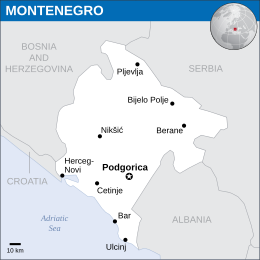More languages
More actions
General-KJ (talk | contribs) m (Added category) Tag: Visual edit |
mNo edit summary Tag: Visual edit |
||
| Line 1: | Line 1: | ||
{{Infobox country|name=Montenegro|native_name=Црна Гора|image_flag=Flag of Montenegro.svg|image_coat=Coat of arms of Montenegro.svg|capital=Podgorica|largest_city=Podgorica|mode_of_production=[[Capitalism]]|image_map=Montenegro map.svg|map_width=260|official_languages=Serbo-Croatian|area_km2=13,812|population_estimate=602,445|population_estimate_year=2023}} | {{Infobox country|name=Montenegro|native_name=Црна Гора|image_flag=Flag of Montenegro.svg|image_coat=Coat of arms of Montenegro.svg|capital=Podgorica|largest_city=Podgorica|mode_of_production=[[Capitalism]]|image_map=Montenegro map.svg|map_width=260|official_languages=Serbo-Croatian|area_km2=13,812|population_estimate=602,445|population_estimate_year=2023}} | ||
'''Montenegro''' is a country in the [[Balkans]]. It was part of the [[Socialist Federal Republic of Yugoslavia (1945–1992)|SFR Yugoslavia]] from 1945 to 1992 and remained part of the [[Federal Republic of Yugoslavia (1992–2006)|FR Yugoslavia]] until 2006. | '''Montenegro''' is a country in the [[Balkans]]. It was part of the [[Socialist Federal Republic of Yugoslavia (1945–1992)|SFR Yugoslavia]] from 1945 to 1992 and remained part of the [[Federal Republic of Yugoslavia (1992–2006)|FR Yugoslavia]] and later [[Serbia and Montenegro (2003-2006)|Serbia and Montenegro]] until 2006. | ||
== History == | == History == | ||
Revision as of 13:01, 27 January 2024
| Montenegro Црна Гора | |
|---|---|
 | |
| Capital and largest city | Podgorica |
| Official languages | Serbo-Croatian |
| Dominant mode of production | Capitalism |
| Area | |
• Total | 13,812 km² |
| Population | |
• 2023 estimate | 602,445 |
Montenegro is a country in the Balkans. It was part of the SFR Yugoslavia from 1945 to 1992 and remained part of the FR Yugoslavia and later Serbia and Montenegro until 2006.
History
Secession from Yugoslavia
Communists won the 1990 elections in Montenegro and Serbia despite CIA and NED infiltration.[1] In 1997, the Western opposition took power in Montenegro but not Serbia.[2] Montenegrin Prime Minister Milo Đukanović, who had secretly been working with British intelligence since 1991,[3] threatened to secede if Milošević didn't give more autonomy to Montenegro. He also took over federal airports in Podgorica and Tivat.[2]
Ðukanović privatized state industries and openly relied on the mafia and drug cartels for support. Montenegro formally seceded from Yugoslavia in 2006.[3]
NATO puppetization
In 2007, Ðukanović signed an agreement allowing NATO troops and vehicles to occupy Montenegro. He destroyed the country's Yugoslav-era weapons and ordered replacements from Britain and the USA.
In December 2015, when NATO invited Montenegro to join, thousands protested, and Ðukanović lost support from other parties in his coalition. The government published false polling data that said that a majority of citizens supported joining NATO. On the day of a parliamentary vote in October 2016 to elect the prime minister, the internet was shut down and the opposition news website Vijesti was inaccessible around the world. Ðukanović claimed that Russia plotted a coup against him.[3]
Politics
Current Prime Minister Milojko Spajić seeks to join the EU. His coalition relies on support from the anti-imperialist bloc For a Better Montenegro, whose leader Andrija Mandić agreed to support Spajić's government in exchange for becoming Speaker of the Parliament.[3]
References
- ↑ Michael Parenti (2000). To Kill a Nation: 'Divide and Conquer' (p. 26). [PDF] Verso.
- ↑ 2.0 2.1 Michael Parenti (2000). To Kill a Nation: 'The Aggression Continues' (p. 208). [PDF] Verso.
- ↑ 3.0 3.1 3.2 3.3 Kit Klarenberg (2022-11-22). "Hostile takeover: NATO’s annexation of" The Grayzone. Archived from the original on 2023-11-29.


